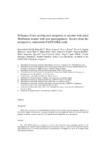Influence of sex on long-term prognosis in patients with atrial fibrillation treated with oral anticoagulants. Results from the prospective, nationwide FANTASIIA study

Ver/
Use este enlace para citar
http://hdl.handle.net/2183/25677
A non ser que se indique outra cousa, a licenza do ítem descríbese como Creative Commons Attribution-NonCommercial-NoDerivs 4.0 International License (CC-BY-NC-ND 4.0)
Coleccións
- GI- GRINCAR - Artigos [226]
- INIBIC-ECAPE - Artigos [31]
Metadatos
Mostrar o rexistro completo do ítemTítulo
Influence of sex on long-term prognosis in patients with atrial fibrillation treated with oral anticoagulants. Results from the prospective, nationwide FANTASIIA studyAutor(es)
Data
2020-04-14Cita bibliográfica
Roldán Rabadán I, Esteve-Pastor MA, Anguita Sánchez M, Muñiz J, Ruiz Ortiz M, Marín F, Roldán V, Quesada MA, Camacho Siles J, Cequier Fillat A, Bertomeu Martinez V, Martínez Sellés M, Badimón L; FANTASIIA Study Investigators. Influence of sex on long-term prognosis in patients with atrial fibrillation treated with oral anticoagulants. Results from the prospective, nationwide FANTASIIA study. Eur J Intern Med. 2020 Aug;78:63-68.
Resumo
[Abstract]
Background: While many risk factors for Atrial Fibrillation (AF) have been identified, there are important differences in their relative impact between sexes. The aim of our study was to investigate the influence of sex as a
long-term predictor of adverse events in “real world” AF patients treated with direct oral anticoagulants.
Methods: The FANTASIIA registry is a prospective, national and multicentric study including outpatients with
anticoagulated AF patients. Baseline characteristics and adverse events at 3 years of follow-up were collected
and classified by sex. Cox multivariate analysis was performed to investigate the role of sex in major events and
composite outcomes.
Results: A total of 1956 patients were included in the study. 43.9% of them were women, with a mean age of
73.8 ± 9.4 years (women were older 76.5 ± 7.9 vs 71.7 ± 10.1, p<0.001). Women had higher rate of cardiovascular risk factors and higher mean of CHA2DS2-VASc (4.4 ± 1.4 vs 3.7 ± 1.6, p<0.001) and HAS-BLED
(2.1 ± 1.0 vs 1.9 ± 1.1, p<0.001) than men. After 3 years of follow-up, rates of major events were similar in
both groups with limit difference for all-cause mortality (4.4%/year in women vs 5.6%/year in men; p = 0.056).
However, all the composite events were more frequent in women. We observed in the non-adjusted adverse
events lower rate of all-cause mortality (HR 0.62, 95%CI 0.47–0.81; p<0.001), composite 1 outcomes (HR 0.80,
95%CI 0.65–0.98; p = 0.029) and composite 2 (HR 0.77, 95%CI 0.64–0.94; p = 0.010) in women compared
with men. In multivariate Cox regression analysis observed that female sex was an independently protector
factor for all-cause mortality and for the composite outcomes 1 and 2.
Conclusions: In this “real world” study of anticoagulated AF patients, women could have a protective role against
development of adverse events, mainly on all-cause mortality and combined events.
Palabras chave
Atrial fibrillation
Role of sex
Direct oral anticoagulants
Vitamin K antagonists
FANTASIIA registry
Role of sex
Direct oral anticoagulants
Vitamin K antagonists
FANTASIIA registry
Versión do editor
Dereitos
Creative Commons Attribution-NonCommercial-NoDerivs 4.0 International License (CC-BY-NC-ND 4.0)
ISSN
1879-0828






